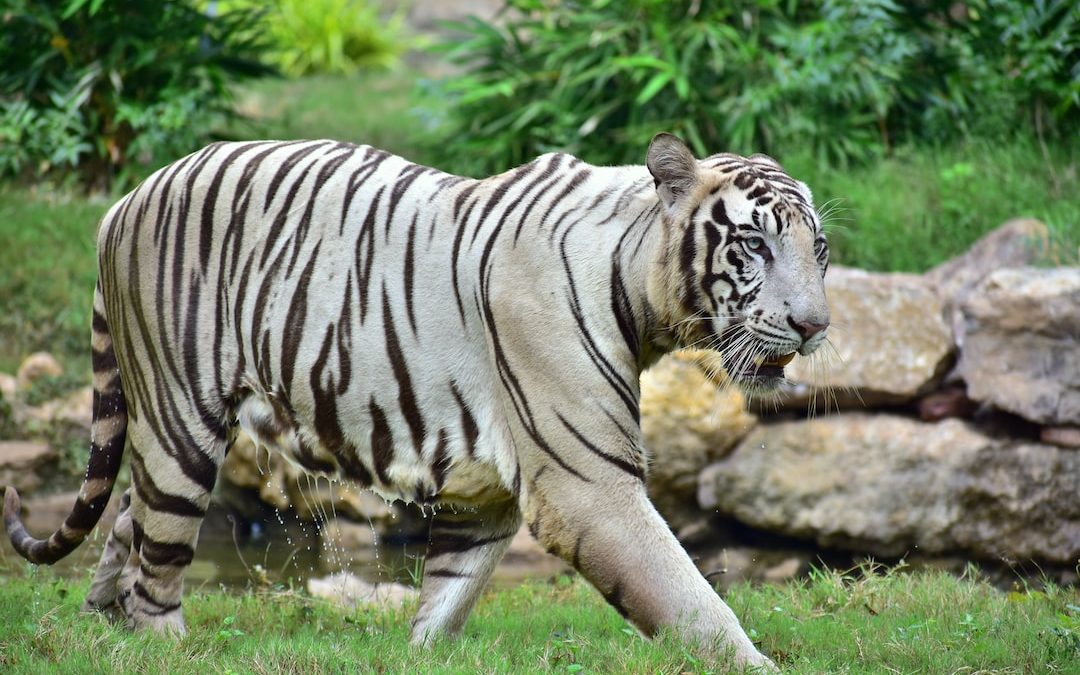Table of Contents
Wildlife Spotting in the Western Ghats: A Look at India’s Endangered Species
The Western Ghats, also known as the Sahyadri Mountains, are a mountain range in India that runs along the western coast of the country. Spanning an area of over 160,000 km2, the Ghats are one of the most biodiverse regions in the world, home to a plethora of unique species of plants, animals, and birds.
Unfortunately, many of these species are now endangered due to human activities such as logging, mining, and deforestation. In this blog post, we’ll take a look at some of the unique species found in the Western Ghats and their current situation in terms of conservation.
Lion-tailed Macaque
The Lion-tailed Macaque, also known as the “dancing monkey”, is a species of Old World monkey endemic to the Western Ghats.
It is one of the most endangered primates in India, with only about 2,500 individuals left in the wild. The species is threatened by habitat loss and fragmentation due to deforestation and agricultural expansion.
The Lion-tailed Macaque is a diurnal species, meaning it is active during the day. It is highly arboreal, meaning it spends most of its time in the trees, and is highly territorial.
Its diet consists primarily of fruits, but it will also eat insects, flowers, and even small reptiles. It is also known for its unique courtship displays, which involve the male making loud calls and engaging in playful behaviors.
Conservation efforts for the Lion-tailed Macaque are in place, with several protected areas and sanctuaries established in the Western Ghats. Additionally, there are several breeding programs and reintroduction initiatives in place for the species, which have helped to increase its population in recent years.
Nilgiri Tahr
The Nilgiri Tahr, also known as the Nilgiri Ibex, is a species of mountain goat endemic to the Western Ghats. It is listed as Vulnerable on the IUCN Red List due to its population size, which is estimated to be around 2,500 individuals. The species is threatened by habitat loss and fragmentation due to deforestation and agricultural expansion.
The Nilgiri Tahr is a diurnal species, meaning it is active during the day. It is highly adapted to the steep terrain of the Western Ghats, and is an excellent climber and jumper.
Its diet consists primarily of grasses, herbs, and shrubs, but it will also eat fruits and flowers when available. It is also known for its loud, distinctive calls, which are used to communicate with other members of its herd.
Conservation efforts for the Nilgiri Tahr are in place, with several protected areas and sanctuaries established in the Western Ghats. Additionally, there are several captive breeding programs in place for the species, which have helped to increase its population in recent years.
Malabar Giant Squirrel
The Malabar Giant Squirrel, also known as the Indian Giant Squirrel, is a species of tree squirrel endemic to the Western Ghats.
It is listed as Endangered on the IUCN Red List due to its population size, which is estimated to be around 10,000 individuals. The species is threatened by habitat loss and fragmentation due to deforestation and agricultural expansion.
The Malabar Giant Squirrel is a diurnal species, meaning it is active during the day. It is highly arboreal, meaning it spends most of its time in the trees, and is highly territorial.
Its diet consists primarily of fruits, nuts, and seeds, but it will also eat insects, flowers, and even small mammals. It is also known for its unique courtship displays, which involve the male making loud calls and engaging in playful behaviors.
Conservation efforts for the Malabar Giant Squirrel are in place, with several protected areas and sanctuaries established in the Western Ghats. Additionally, there are several captive breeding programs in place for the species, which have helped to increase its population in recent years.
Indian Elephant
The Indian Elephant, also known as the Asiatic Elephant, is a species of elephant endemic to the Indian subcontinent. It is listed as Endangered on the IUCN Red List due to its population size, which is estimated to be around 25,000 individuals. The species is threatened by habitat loss and fragmentation due to deforestation and agricultural expansion.
The Indian Elephant is a diurnal species, meaning it is active during the day. It is highly social, living in large groups known as herds. Its diet consists primarily of grasses, leaves, fruits, and bark, but it will also eat roots, tubers, and even small mammals. It is also known for its impressive displays of intelligence, such as its ability to use tools and recognize its reflection in a mirror.
Conservation efforts for the Indian Elephant are in place, with several protected areas and sanctuaries established in the Western Ghats. Additionally, there are several breeding programs and reintroduction initiatives in place for the species, which have helped to increase its population in recent years.
Indian Giant Flying Squirrel
The Indian Giant Flying Squirrel, also known as the Indian Giant Squirrel, is a species of tree squirrel endemic to the Western Ghats.
It is listed as Vulnerable on the IUCN Red List due to its population size, which is estimated to be around 10,000 individuals. The species is threatened by habitat loss and fragmentation due to deforestation and agricultural expansion.
The Indian Giant Flying Squirrel is a nocturnal species, meaning it is active during the night. It is highly arboreal, meaning it spends most of its time in the trees, and is highly territorial. Its diet consists primarily of fruits, nuts, and seeds, but it will also eat insects, flowers, and even small mammals. It is also known for its unique gliding behavior, which involves it launching itself from the trees and gliding up to 50 meters.
Conservation efforts for the Indian Giant Flying Squirrel are in place, with several protected areas and sanctuaries established in the Western Ghats. Additionally, there are several captive breeding programs in place for the species, which have helped to increase its population in recent years.
Tiger
The Tiger, also known as the Bengal Tiger, is a species of large cat endemic to the Indian subcontinent.
It is listed as Endangered on the IUCN Red List due to its population size, which is estimated to be around 3,000 individuals. The species is threatened by habitat loss and fragmentation due to deforestation and agricultural expansion.
The Tiger is a nocturnal species, meaning it is active during the night. It is a solitary and highly territorial animal, and its diet consists primarily of large mammals such as deer, wild boar, and buffalo.
It is also known for its impressive displays of strength and agility, such as its ability to climb trees and swim long distances.
Conservation efforts for the Tiger are in place, with several protected areas and sanctuaries established in the Western Ghats. Additionally, there are several breeding programs and reintroduction initiatives in place for the species, which have helped to increase its population in recent years.
Indian Peafowl
The Indian Peafowl, also known as the Blue Peafowl, is a species of bird endemic to the Indian subcontinent.
It is listed as Vulnerable on the IUCN Red List due to its population size, which is estimated to be around 20,000 individuals. The species is threatened by habitat loss and fragmentation due to deforestation and agricultural expansion.
The Indian Peafowl is a diurnal species, meaning it is active during the day. It is highly social, living in large flocks known as “pea-bays”.
Its diet consists primarily of insects, berries, and seeds, but it will also eat small mammals and reptiles. It is also known for its spectacular courtship displays, which involve the male displaying its colorful feathers to attract the female.
Conservation efforts for the Indian Peafowl are in place, with several protected areas and sanctuaries established in the Western Ghats. Additionally, there are several captive breeding programs in place for the species, which have helped to increase its population in recent years.
Indian Rhinoceros
The Indian Rhinoceros, also known as the Great One-horned Rhinoceros, is a species of large mammal endemic to the Indian subcontinent.
It is listed as Vulnerable on the IUCN Red List due to its population size, which is estimated to be around 3,500 individuals. The species is threatened by habitat loss and fragmentation due to deforestation and agricultural expansion.
The Indian Rhinoceros is a diurnal species, meaning it is active during the day. It is a solitary and highly territorial animal, and its diet consists primarily of grasses and leaves.
It is also known for its impressive displays of strength and agility, such as its ability to run up to 30 kilometers per hour and jump up to two meters in the air.
Conservation efforts for the Indian Rhinoceros are in place, with several protected areas and sanctuaries established in the Western Ghats. Additionally, there are several breeding programs and reintroduction initiatives in place for the species, which have helped to increase its population in recent years.
Indian Pangolin
The Indian Pangolin, also known as the Thick-tailed Pangolin, is a species of scaly anteater endemic to the Indian subcontinent.
It is listed as Endangered on the IUCN Red List due to its population size, which is estimated to be around 2,000 individuals. The species is threatened by habitat loss and fragmentation due to deforestation and agricultural expansion.
The Indian Pangolin is a nocturnal species, meaning it is active during the night. It is a solitary and highly territorial animal, and its diet consists primarily of ants and termites.
It is also known for its impressive displays of strength and agility, such as its ability to roll itself into a ball and use its sharp scales to ward off predators.
Conservation efforts for the Indian Pangolin are in place, with several protected areas and sanctuaries established in the Western Ghats. Additionally, there are several captive breeding programs in place for the species, which have helped to increase its population in recent years.
Summary
The Western Ghats are an incredibly biodiverse region, home to a plethora of unique species of plants, animals, and birds.
Unfortunately, many of these species are now endangered due to human activities such as logging, mining, and deforestation. In this blog post, we took a look at some of the unique species found in the Western Ghats and their current situation in terms of conservation.
Conservation efforts are in place for many of these species, such as protected areas, sanctuaries, breeding programs, and reintroduction initiatives, which have helped to increase their populations in recent years. However, more needs to be done if we are to ensure the survival of these unique and endangered species.












